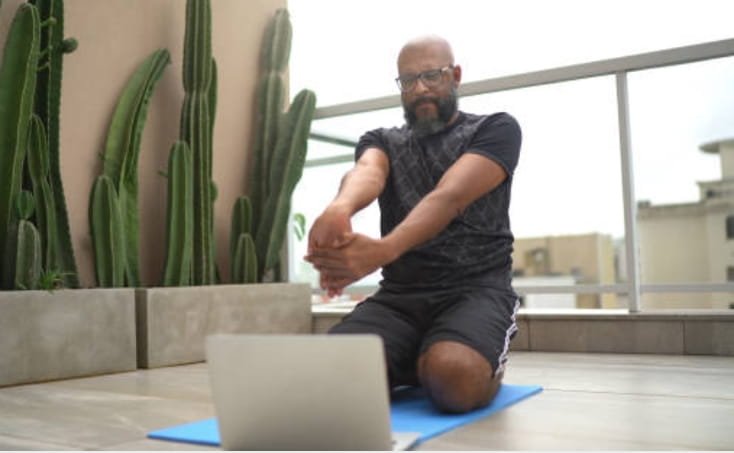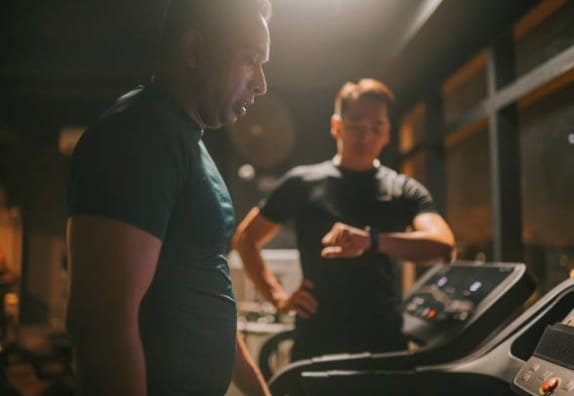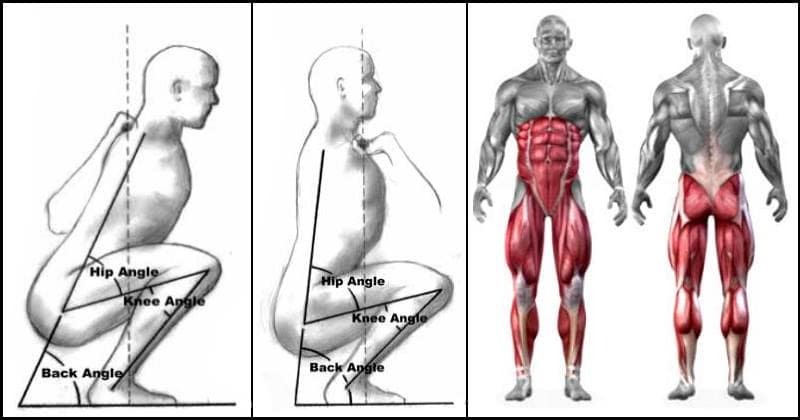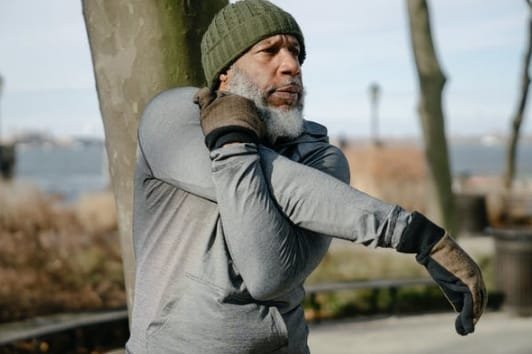
by admin | Jun 10, 2022 | Workouts
Training For Men Over 40 | Why & How You Should Train
Most men are scared of aging but if you do the right things, you won’t “get older” but you’ll rather age well like fine wine. Naturally, as men age, testosterone levels go down and that leads to a change in the mental and physical state.
In this article, we’ll reveal the benefits of training into your older years and tell you exactly how you can approach this, in order to reap long-lasting benefits.
Why You SHOULD Train In Your Older Years

“I don’t train, I’m already old and the results are way slower than they would if I had started young…”. This is one of the most common excuses you hear from men over 40, which they use to justify the lack of movement in their life. Well, though this is a common belief, the fact of the matter is that while the response may not be as prominent, training is still a good stimulus regardless of age.
Whether you’re 15, 25, or 40+, including certain types of training in your lifestyle, will increase your health and improve the overall quality of life. More specifically, strength training has been proven to be a good anti-aging tool, which helps maintain normal testosterone levels. So again – You’re helping your body as time goes by and by maintaining it, you bring a healthy, functional, good-looking body into your older years.
What Training Should You Do?
When it comes to training, it is a fact that exercise relies on principles, which makes the end result predictable. There are different types of training which in turn, bring different end results, so let’s analyze the most common types of training you can take on.
Strength Training

The goal of training is to usually get the best out of it, whether we’re talking about how you look, perform or feel. After 40, it is likely that you won’t be after a competitive sports career, so naturally, you’d be more inclined to do training that focuses on overall development and wellbeing.
Strength training is the type of training you should focus on if your goal is to:
- Improve strength
- Look better
- Feel better
- Optimize testosterone production
- Be more athletic overall
As we already mentioned, strength training is literally the fountain of youth for men over 40. This is due to the fact that this type of training causes a strong anabolic (constructive) response in the body, making it a nourishing activity for practically your entire body and mood. With strength training, you will observe improvements in strength & strength endurance, muscular tone, overall mood, sex drive, and overall athleticism.
As an adult man, this is the type of training you should primarily focus on.
Cardio training

Low-intensity, prolonged sessions are referred to as “cardio” and are the type of activity that most often comes to mind when you think of “training”. This type of training has its benefits, which are primarily expressed in the increased efficiency of your heart & lungs.
Cardio training is the type of training you should go for if you’re looking to:
- Increase endurance
- Improve heart & lung health and function
- Burn some extra calories
- Be healthier overall
The thing about prolonged cardio is that it causes the release of cortisol, which in turn may lower testosterone levels.
This is why it is recommended to do some cardio but not too much and instead, focus most of your energy on your strength training sessions. Cardio is optimally done after strength training, for 20-40 minutes at a moderate pace. Including regular cardio in your routine may improve muscle tone, overall health & mood.
Frequently Asked Questions
What we said above is very generic and it just displays the benefits of different types of training you can do. Now let’s get a little more specific and dig into the details which can help you set up a training plan.
#1 What type of strength exercises should I do?
The goal with strength training is to create a stimulus that is as prominent as possible. Compound exercises that involve more than 1 joint and muscle group at a time, are your best choice, whether you’re a young or adult male. These are exercises like squats, deadlifts, bench presses, overhead presses, pull-ups, dips and other dumbbell, barbell & kettlebell exercises.
Such movements will allow you to lift significantly heavier weights, due to the greater amount of muscle fibers engaged. This will therefore create a greater stimulus & biological response but then again, you shouldn’t lift too heavy, as you want to sustain this performance and avoid injury.
#2 How many sets and reps should I do?
The question of sets and reps is controversial and you can easily get misinformed but the fact of the matter is that the number of sets and reps depends on the goal you want to achieve. You want to increase your maximal strength? Focus on 1-5 reps (powerlifting range) You want to create the most visually appealing physique? Focus on 5-15 reps (bodybuilding range).
Ultimately, your best bet would be to combine both the powerlifting & bodybuilding range, as that will allow you to stimulate the muscles across all their properties (strength, strength endurance, explosiveness, etc.) As to the number of sets, it is generally best to start off at 5+ working sets per muscle group per week (as a beginner) and increase that number as you progress, up to 10-20+ challenging sets.
#3 How often should I train?
When you workout, you do micro damage to your muscles and so, you need to carefully manage your recovery between workouts, in order to perform at your best from workout to workout. Generally for strength training, optimal recovery comes around the 48th-96th hour after training.
Basically, you should train each muscle group again, when it is at its peak recovery state (48th-96th hr after a workout). Think of it this way – Since your performance declines after a certain point in your workout, it is best to do 2 workouts with 5 working sets, rather than 1 workout with 10 sets.
Why? Because it would realize a greater total working volume (total amount of weight lifted) and thus, create a more powerful stimulus for the body.
#4 What type of cardio training should I do?
Cardio is a great tool to use for recovery, unwinding and relaxation when you’re not in the gym lifting weights. This type of training implies a low-intensity, prolonged training session and there are MANY such activities. We’d advise you to avoid limiting your cardio to just the treadmill.
Instead, do some running outside, ride your bicycle, do some swimming, some rope jumping or even some quick walking. These activities are best done after strength training or on your off days. If your goals primarily resonate with what strength training provides as an end result, you shouldn’t do too much cardio, as it may rob you of the energy for your strength workouts.
#5 How often should I do cardio?
The last sentence of point number 4 brings us to this question but the thing is… There is no definitive answer. But we can say this for sure – If you are primarily looking for increases in strength, strength endurance, muscular tone & testosterone production, overdoing cardio can be suboptimal.
We’d generally recommend doing 2-4 cardio sessions per week, lasting ~40 minutes. These are done after your strength workouts, or on days when you don’t go to the gym. We are not completely signing cardio off, as it is highly beneficial for the heart, lungs and your overall health. It can even be used as a great tool to recover from strength workouts.
All we’re saying is – If you do a lot of cardio, make sure you’re also eating more nutrient-rich, whole foods that provide all nutrients to the body.
You’ll need that energy!
Conclusion
As men age, testosterone levels naturally decline and so, training can be used as a tool to mitigate the effects of getting older and help you age like fine wine. If you’re an adult male, you should primarily focus on strength training, taking on compound, heavy exercises that engage more muscles at once.
The exertion should be moderately high and hard failure must not be reached too often, as that may increase the chance of injury or physical burnout. Ultimately, you should be looking to mix strength & cardio training, along with recovery practices like stretching & massages. Think of it as using the body every day and doing some activity regularly, even if it’s for 15-30 minutes only.
Movement is energy and so, if you want an optimally-functioning body as an adult, you should do your best to keep your body active & healthy, through training and nutrition.

by admin | Jun 10, 2022 | Workouts
Volume Cycling In Training
Training volume appears to be one of the factors that play a primary role in inducing muscle development stimulus. And though it is an important one, it needs to be properly combined with intensity and rest times. When you combine both, to create an effective working volume, you can start playing around with the numbers of sets and reps, to emphasize the development of certain body parts.
In this article, we’ll take you through the basics of volume cycling to give you insight on how you can improve your lacking areas.
What Are Volume & Intensity
Training intensity & training volume are two separate training variables, which have to be very well combined, as we already mentioned.
Intensity increases the closer you get to your maximum strength capabilities on a given exercise. For instance, if you can bench press 100 kg for 1 rep and fail to do a second rep unassisted, 100 kg represents 100% intensity for you, for that exercise.
Volume on the other hand, represents the total amount of weight lifted on a given set, exercise or a workout. For example, if we take that same 1 rep set with 100 kg, that would be a volume of 100 kg. Oppositely, if you do 10 repetitions with 100 kg, that would be a volume of 1000 kg (Volume = Weight * Sets * Reps)
What Is The Optimal Training Volume?

When you combine intensity and volume, you get a workload that is challenging and each set takes you within 2-4 reps shy of failure. This is effective volume and should be at the core of your workouts, whether you are training for strength or for bulk muscle growth. The optimal training volume forms at 10-20 challenging working sets, per muscle group, per week, depending on your level of training.
Beginners for example can reap benefits with just 5-6 sets per week, but as you progress and reach 15-20 sets, plateaus in development may be reached.
What is Volume Cycling?

Trying to build up all muscle groups all at once may be a challenging and unsustainable task, because all compound exercises engage multiple muscle groups. For this reason, it often happens that you may not be able to get to peak recovery, especially on your weaker muscle groups.
This is when you can implement the concept of volume cycling, which implies a slight decrease in the volume for already well-developed muscle groups, and an increase for the weaker muscle groups.
Technically, this concept works for bringing up weak body parts, because the minimum volume you can MAINTAIN the well-developed muscle groups at, is about 30% of your minimum effective volume (i.e you can do ~5 sets per muscle group per week and maintain it).
Example Of Training Adjustments
Now, though you will be putting priority on your weaker muscle groups, you should still consider choosing exercises that work WITH your stronger body parts. Those are compound movements that allow you to lift heavy weights, but on top of that, you can also include a good amount of volume with isolated movements.
For instance, if your chest is well developed, but your triceps are lacking, focus more on close grip bench press & triceps dips – This primarily engages the triceps, but also the chest and shoulders.
This is mostly applicable for the upper body, where certain exercises for the bigger muscle groups, may leave the smaller muscle groups exhausted and unable to complete quality volume.
Tips For Bringing Up Lacking Muscle Groups
Manipulating your training variables is one of the most important things about bringing up weaker muscle groups. Besides that, you can view your training split and week as a cycle, where you usually have the most energy and focus at the beginning.
For this reason, you can structure your training around the weaker muscle groups by:
- Placing them first in the training split
- Placing them first in the workout
Furthermore, you can apply volume cycling, place a cooldown on dominant muscle groups and focus on the lacking ones by increasing the weight, sets and repetitions.
To Wrap It Up
Training volume is an essential part of your workout and when combined with intensity, it can create a powerful stimulus for overall muscular development. Nevertheless, sometimes it happens that some muscle groups develop faster than others, leaving lacking muscle groups behind. This is exactly when you can reload on the well-developed groups and pump up the quality volume in favor of your weaker ones.
Ready to achieve aesthetics? Go for it!

by admin | Jun 10, 2022 | Workouts
The Core & Vacuum Training
Many people get into the gym for the sole purpose of developing a good-looking midsection and more specifically, a six-pack. However, what we have in the middle of the body is far more than just abs, as this portion of your torso is responsible for a variety of important functions. In this short article, we’ll reveal in detail what you should know about the abs, core, their functions and how to train them with a long-forgotten, old-school exercise – The stomach vacuum.
The Core 101
For the most part, when you hear the word “core” you may think of your sixpack, but the truth is different. The six-pack is just a part of your core and works in synergy with other muscles around it, to ultimately:
- Keep your posture good
- Stabilize internal organs
- Keep you on your feet
- Exert force using other muscle groups
It is considered that the core is made up of the external and internal abdominal muscles, the glutes, the spinal erectors, obliques and the diaphragm.
Static VS Dynamic Exercises

Though crunches are a very popular exercise for the abs, they don’t even get close to the full functional potential of your core. As a matter of fact, the abdominals have a variety of functions, both dynamic & static. For instance, leg raises would allow the abs to contract and relax dynamically, while just holding your legs raised in a static position would contract the abs statically.
Both of these functions should be exercised during your training, to achieve maximum development.
Here are some of the best static & dynamic exercises you can do for the abs:
- Hanging knee raises
- Hanging leg raises
- Side to side leg raises
- Front lever drills
- Full front lever
- Russian twists
- Boxing bag upside down crunches
- Dragon flag
- L-Sit
The Stomach Vacuum

A chiseled set of abs will give your waistline a complete overhaul and if you want to emphasize on that even further, you can implement the stomach vacuum in your training routine. With this exercise, you will engage the internal abdominal muscles and your waistline will naturally become more tucked in.
Additionally, this is a whole workout for the sixpack as well, so do develop new, unseen before lines all over your midsection! Here’s how to do the stomach vacuum:
- Stand up on your feet
- Take a completely straight body position
- Take a deep breath
- Slowly exhale and contract the abs while holding your breath
- Swallow the abdominal wall in and under the rib cage
- Hold this vacuum for a couple of seconds and release
Initially, this may feel odd but with time, you will start feeling more and more mind-muscle connection. This exercise is best done on an empty stomach and can be practically completed every single day.
Take Home Message
The core is made up of a variety of muscle groups with the abdominals being the predominantly recognized one.
Your abs and obliques serve a variety of important functions that allow for body stability during complex movements, which is why you should train them both dynamically and statically. The stomach vacuum is one of the exercises that will allow you to engage the deep abdominal muscles, thus contributing to a better overall development.
Stay aesthetic!

by admin | Jun 6, 2022 | Workouts
The 3 Training Factors
If you’ve been in the game of training for some time, or are relatively new and are just gathering information, you probably know that training progress is only achieved by creating proper stimulus.
And while you can look for workouts on the internet, there is one very important thing to learn and understand – What’s actually happening beneath your skin when you’re training, that leads to progress?
In this article, we’re going to look at the 3 most important factors in your workout that induce sufficient stimulus for progress.
The Muscles

Before we dive deep into those 3, let us just tell you that your musculature is a complex system, built for high performance.
The muscle tissue is very adaptive and for that reason, it grows stronger and bigger if it has to do a lot of work.
Oppositely, if it doesn’t do any work, it will get weaker – If you don’t use it, you lose it!
The 3 Factors – Metabolic Stress, Mechanical Tension, Muscle Damage
When we look into the science of muscle growth, it appears that these 3 factors are the primary contributors that trigger the pathways that lead to muscle growth. Let’s have a look at why that actually makes sense
In order to grow and adapt, the muscles need more mechanical tension, created by the progressively increasing training load (more weight, sets, reps). When exposed to a new load that the muscles have never experienced before, the muscles are technically overloaded.
In turn, to endure this, the muscles send signals to satellite cells, which bind to the damaged muscle cells and in result, the muscle adapts and grows. This implies that mechanical tension is what induces muscle damage and that therefore sets off a flurry of reactions in the body that allow the muscle to recover and increase its volume, capacity and efficiency.
Pretty cool, right?
What About Metabolic Stress?
The third important factor for muscle development is metabolic stress, which may sound like a fancy term but let us explain. Basically, while you are training at a high intensity with weights, you use up a lot of the muscles’ energy. Needless to say, all this energy is broken down into byproducts, which we refer to as “metabolites”.
These metabolites act as “anabolic signals” that, again, set off a hurricane of anabolic (constructive) processes that allow for muscle recovery and adaptation.
How Should I Train, Then?
Generally, in your workouts, you should look for a balance of effort and volume. For instance, lifting just the bar for 100 repetitions won’t really cut it. Choose a weight that is challenging enough to take you through a set of 6-10 reps, but just a couple of reps shy of failure. Use challenging weights and do 10-20 of those, per muscle group, per week.
You should even consider going down to the strength rep range of 1-5 repetitions. All of this will help you create a strong, aesthetic, stamina-abundant body, which, with the right approach, you can take to your older years.
To Wrap It Up
It appears that metabolic stress, mechanical tension and muscle damage are the 3 primary factors that set off the reactions that allow the muscles to adapt and grow stronger.
Neither one alone will be optimal, which is why in practice, you should rely on challenging lifts in your workouts, in sets that take you close to failure.
Train smart, stay consistent!

by admin | Jun 5, 2022 | Fitness, Workouts
Legs & Abs Exercises You Aren’t Doing That You Should Do
If you are like most people, you probably think you are doing all the exercises that you should be. However, there are probably a few exercises that you are neglecting that can provide some major benefits. In this blog post, we will outline four exercises that you may not be doing, but should definitely add to your routine. Keep reading to learn more!
#1 Front Squats

Many people do back squats, where the barbell is placed on the top of the traps, but not that many people do front squats. Front squats are one of the most effective lower-body exercises because they place a slightly different emphasis as opposed to back squats. This is because the barbell is placed on your shoulders, rather than on your back. Additionally, front squats can help you keep your spine safe and bring up your glutes if they are lacking.
#2 Romanian Deadlifts
Romanian deadlifts are one of the best exercises for the hamstrings and glutes. This type of deadlift is a compound exercise that involves both the lower and upper body, making it an extremely effective way to train the entire body. But really, as we just said, where this exercise shines, is its ability to target the glutes and hamstrings! Usually, deadlifts are done on the days when you train back, but with this variation, you can include it on your lower body training days!
#3 Hanging Leg Raises
Hanging leg raises are one of the most effective exercises for the abs. This is because they work the entire abdominal area, including the lower abs, which are often difficult to target. To do a leg raise, you can in fact start with a knee raise! Hang on a pull-up bar and lift your knees up to your chest, contracting the abs.
Once you get used to this movement and controlling the swinging of your body, move on to a leg raise, where you flex your ankle, keep the legs straight at the knee and bring them up. Here’s a cue: Try touching the ceiling with your toes!
#4 Stomach Vacuums

Speaking of effective ab movements, we can’t skip the stomach vacuums! The stomach vacuum exercise is a bodybuilding move that originates from the golden era of the sport. It was first made popular by bodybuilder and fitness icon Frank Zane, and has been used by top-level athletes and bodybuilders for decades. The exercise is simple but extremely effective, and can help you achieve a tight, toned midsection. And doing it is quite simple:
- Put your hands on your knees
- Exhale fully, while flexing your abs
- Keep the abs flexed
- Tuck your abdominal wall under your ribcage
- Hold briefly!
Conclusion
If you’re looking to change up your leg and abdominal routine, give some of these exercises a try.You may find that you enjoy them more than the standard exercises you usually do, and they could help you achieve better results. And if you don’t like any of these suggestions, there are plenty of other exercises out there that can help strengthen your legs and abs. Stay tuned on our website!

by admin | May 30, 2022 | Workouts
How To Make Your Workouts More Effective
As the old saying goes, “nothing worth having comes easy.” The same holds true for fitness – getting in shape and achieving your goals requires hard work and dedication. But that doesn’t mean your workouts have to be a drag.
With a few simple tweaks, you can make your workouts more effective and enjoyable. Read along for some tips to boost the effectiveness of your training sessions!
#1 Stick To The Basics

One of the biggest misconceptions for trainees when they step into the gym is that they constantly have to do new and fancy workouts. This is commonly referred to as things done to “confuse the body” and push it towards progress. Supersets, drop sets, low rest times, you name it – Most trainees do a ton of weird things due to the absence of knowledge about what’s actually effective.
Truth be told, there is nothing more effective than the basics – Compound exercises, done with heavy weights, consistently over time!
#2 Train At The Right Intensity
Speaking of heavy weights, one of the most critical factors of a workout is the training intensity. By intensity, we simply mean the amount of weight used because the closer you get to your maximum strength capabilities, the higher the intensity level is.
This is, by definition, the description of ‘training intensity.’
Generally speaking, if your main goal is to increase your maximum strength, you are best off training at around 85-100% of your maximum strength capabilities (1-5 reps). Oppositely, if your main goal is to gain the maximum amount of muscle mass, you should aim at the 70-85% range (6-15 reps). Ultimately, however, you are best off combining both ranges but emphasizing the one that most suits your goals!
#3 Rest More!

If you go to the gym, you will often see people doing various exercises restlessly. As we mentioned, methods like supersets and drop sets are emphasized much more than they should be nowadays. What many people forget, however, is that the training intensity you achieve at the gym is quite demanding and strenuous, both for the nervous system and the muscles.
What does this mean for you? Well, it simply means that you’d need more rest time between sets in order to sustain your performance from set to set! Think of it this way – In every workout that you do, the goal is to create the biggest quality volume of work possible.
For instance, if you use 100 kg for 1 set of 10 reps and then rest just 30-60 seconds, you will likely only get eight or fewer repetitions on the next sets. However, if you use that same weight for multiple sets but rest more, it is likely that you will sustain the same number of repetitions, thus lifting more total weight.
Generally speaking, optimal rest times form at about 2.5-3 minutes between sets, depending on how close you were to failure.
#4 And Then Some More.
Last but not least, to make your workouts effective, you have to not only do things at the gym but also outside of it! Resting enough between your workouts is detrimental to sustained and improved performance over time. Why? Because weighted workouts are quite demanding, as we mentioned, and the body takes time to adapt and come back stronger!
Depending on the training volume, allowing each muscle group to rest between 48 and 96 hours after being trained directly would get you in the ballpark of good recovery!
Final Thoughts
We hope this article has given you some new ideas on how to make your workouts more effective. Remember, if it doesn’t work out for you the first time around, don’t give up! Keep trying different things until you find what works best for both your body and mind, but don’t forget – Stick to the basics!
And as always, stay tuned for our upcoming articles to help you improve on your fitness, nutrition, and the mental game!























